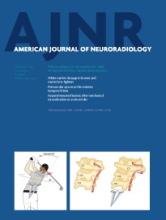Index by author
Castillo, M.
- EditorialsYou have accessEditorial TransitionM. CastilloAmerican Journal of Neuroradiology February 2014, 35 (2) 213; DOI: https://doi.org/10.3174/ajnr.A3882
- EditorialsYou have accessTrainees in Peer Review: Our ExperienceM. CastilloAmerican Journal of Neuroradiology February 2014, 35 (2) 211-213; DOI: https://doi.org/10.3174/ajnr.A3548
Cebral, J.
- NeurointerventionOpen AccessQuantifying the Large-Scale Hemodynamics of Intracranial AneurysmsG. Byrne, F. Mut and J. CebralAmerican Journal of Neuroradiology February 2014, 35 (2) 333-338; DOI: https://doi.org/10.3174/ajnr.A3678
Chang, C.N.
- BrainOpen AccessAssessment of Angiographic Vascularity of Meningiomas with Dynamic Susceptibility Contrast-Enhanced Perfusion-Weighted Imaging and Diffusion Tensor ImagingC.H. Toh, K.-C. Wei, C.N. Chang, Y.-W. Peng, S.-H. Ng, H.-F. Wong and C.-P. LinAmerican Journal of Neuroradiology February 2014, 35 (2) 263-269; DOI: https://doi.org/10.3174/ajnr.A3651
Cheng, Q.-G.
- EDITOR'S CHOICEBrainOpen AccessUse of FLAIR Imaging to Identify Onset Time of Cerebral Ischemia in a Canine ModelX.-Q. Xu, Q.-Q. Zu, S.-S. Lu, Q.-G. Cheng, J. Yu, Y. Sheng, H.-B. Shi and S. LiuAmerican Journal of Neuroradiology February 2014, 35 (2) 311-316; DOI: https://doi.org/10.3174/ajnr.A3689
After an infarction-inducing procedure, 20 dogs were imaged at 3, 4, 5, 6, and 24 hours with FLAIR and DWI. A mismatch between the 2 sequences (positive DWI and negative FLAIR) was found to reliably predict the time of infarct onset. By 6 hours, 95% of dogs had FLAIR abnormalities and by 24 hours all did. However, at 3 hours only 15% of dogs showed positive FLAIR studies. These results could serve as guidelines to estimate the time of onset of ischemic events.
Cho, S.H.
- FELLOWS' JOURNAL CLUBBrainYou have accessUtility of Proton MR Spectroscopy for Differentiating Typical and Atypical Primary Central Nervous System Lymphomas from Tumefactive Demyelinating LesionsS.-S. Lu, S.J. Kim, H.S. Kim, C.G. Choi, Y.-M. Lim, E.J. Kim, D.Y. Kim and S.H. ChoAmerican Journal of Neuroradiology February 2014, 35 (2) 270-277; DOI: https://doi.org/10.3174/ajnr.A3677
The utility of MRS in differentiating lymphoma from tumefactive demyelination was assessed in 44 patients with the former and 21 with the latter. A Cho/Cr over 2.58 and a high lipid/lactate peak were more common in lymphoma, therefore MRS may help in differentiating these 2 entities.
Choi, C.G.
- FELLOWS' JOURNAL CLUBBrainYou have accessUtility of Proton MR Spectroscopy for Differentiating Typical and Atypical Primary Central Nervous System Lymphomas from Tumefactive Demyelinating LesionsS.-S. Lu, S.J. Kim, H.S. Kim, C.G. Choi, Y.-M. Lim, E.J. Kim, D.Y. Kim and S.H. ChoAmerican Journal of Neuroradiology February 2014, 35 (2) 270-277; DOI: https://doi.org/10.3174/ajnr.A3677
The utility of MRS in differentiating lymphoma from tumefactive demyelination was assessed in 44 patients with the former and 21 with the latter. A Cho/Cr over 2.58 and a high lipid/lactate peak were more common in lymphoma, therefore MRS may help in differentiating these 2 entities.
Choi, H.A.
- EDITOR'S CHOICEBrainYou have accessPreferential Location for Arterial Dissection Presenting as Golf-Related StrokeM.H. Choi, J.M. Hong, J.S. Lee, D.H. Shin, H.A. Choi and K. LeeAmerican Journal of Neuroradiology February 2014, 35 (2) 323-326; DOI: https://doi.org/10.3174/ajnr.A3768
Seven patients with golf-related strokes were imaged and the literature was reviewed for similar cases, which generated a total 14 such occurrences. The most common time of symptom onset occurred during the golf swing and over one-half of patients damaged an extracranial vertebral artery with most dissections involving the right side. Of a total of 14 dissections, 7 patients had complete symptom resolution and returned to normal.
Choi, M.H.
- EDITOR'S CHOICEBrainYou have accessPreferential Location for Arterial Dissection Presenting as Golf-Related StrokeM.H. Choi, J.M. Hong, J.S. Lee, D.H. Shin, H.A. Choi and K. LeeAmerican Journal of Neuroradiology February 2014, 35 (2) 323-326; DOI: https://doi.org/10.3174/ajnr.A3768
Seven patients with golf-related strokes were imaged and the literature was reviewed for similar cases, which generated a total 14 such occurrences. The most common time of symptom onset occurred during the golf swing and over one-half of patients damaged an extracranial vertebral artery with most dissections involving the right side. Of a total of 14 dissections, 7 patients had complete symptom resolution and returned to normal.
Cirillo, M.
- BrainYou have accessFrontotemporal Cortical Thinning in Amyotrophic Lateral SclerosisA. d'Ambrosio, A. Gallo, F. Trojsi, D. Corbo, F. Esposito, M. Cirillo, M.R. Monsurrò and G. TedeschiAmerican Journal of Neuroradiology February 2014, 35 (2) 304-310; DOI: https://doi.org/10.3174/ajnr.A3753
Clement, F.M.
- NeurointerventionYou have accessWhen Is Carotid Angioplasty and Stenting the Cost-Effective Alternative for Revascularization of Symptomatic Carotid Stenosis? A Canadian Health System PerspectiveM.A. Almekhlafi, M.D. Hill, S. Wiebe, M. Goyal, D. Yavin, J.H. Wong and F.M. ClementAmerican Journal of Neuroradiology February 2014, 35 (2) 327-332; DOI: https://doi.org/10.3174/ajnr.A3682








